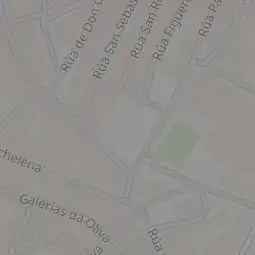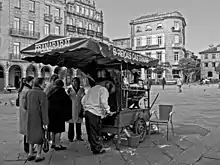Plaza de la Herrería
The Plaza de la Herrería (Blacksmith's square) is a large square located on the edge of the old town of Pontevedra (Spain), inside the old city walls. It is the main square of the old town and has an area of about 2,000 m2. It includes the small squares of the Estrella on the north side, the Orense square on the south side and the Casto Sampedro square on the east side, making a total of almost 5,000 m2.
.jpg.webp) Blacksmith's square | |||
 | |||
| Native name | Praza da Ferrería (Galician) | ||
|---|---|---|---|
| Type | plaza | ||
| Maintained by | Pontevedra City Council | ||
| Location | Pontevedra, Spain | ||
| Postal code | 36002 | ||
| Coordinates | 42.431406°N 8.644246°W | ||
Origin of the name
The square takes its name from the forges that were located there in the Middle Ages, since the Catholic Monarchs decreed certain orders to arm the Spanish knights with arms from Pontevedra and Oviedo.[1]
History
The first references to the square date from between 1325 and 1330. In the Middle Ages it was known as the Plaza de Trabancas, and it took on the name of Herrería around 1820 in memory of the old craftsmen and Blacksmiths who lived there, who made all sorts of weapons and iron instruments and who became famous throughout the country.
The square was enlarged in the 15th century to accommodate the Feira Franca market,[2] a tax-free market that began to take place in the city by a royal privilege established by King Henry IV in 1467.
.png.webp)
In the middle of the Casto Sampedro square, on the eastern side of the square, there is a 16th century fountain that stood on the paved side of the square, in the middle, until 1857.[3] Financed in 1537 by Charles V,[4] whose coat of arms it bears, and completed 15 years later,[5] it was built in the style of Portuguese fountains (chafariz) by João Lópes and Domingo Fernández. The fountain was used to welcome pilgrims on their way to Santiago de Compostela after entering the walled enclosure of the city through the Trabancas gate of the walls. It is mentioned in the popular song:[6]
|
PONTEVEDRA É BOA VILA |
Pontevedra is a good city |
In 1845, the land below the Convent of St. Francis was levelled for landscaping. In 1928, the fountain was restored and installed in the Casto Sampedro square (the result of this landscaping), some fifty metres from its original location. It served as a model for many of the fountains that were built in the cloisters of convents and in front of some pazos.
Between 1854 and 1931, the square was called Plaza de la Constitución. The city's market was once held on the paved side of the square. In 1910, the square was remodelled and paved. The two modernist buildings were built opposite the convent of San Francisco, where the stairs were built and the gardens were designed.
Description
The streets of Soportales de la Herrería, Conde de San Román, Pasantería, Benito Corbal, Figueroa, and the old Trabancas Gate of the walls, which is part of the Portuguese Way, lead to it. Next to it is the church of the Pilgrim Virgin.

Its commercial premises are mostly textile or hotel establishments. The famous Almacenes Clarita textile shop opened in 1916.[7] The square is located next to the Convent of St. Francis and the small squares of the Estrella (700 m2), and Orense (700 m2), as well as the 1,000 m2 Casto Sampedro square.
Two of the city's oldest cafés are located in the square: Café Savoy (now Restobar Savoy), an intellectual meeting place since 1936, and Carabela, which opened ten years later, in 1946.[8]
Remarkable buildings
The buildings in the square date from the 14th to the 20th century. To the east and north of the square are the convent and the Gothic church of San Francisco, and below, in the middle of the Casto Sampedro square, is the famous Renaissance fountain of La Herrería. To the west of the square, above the arcades, are two Art Nouveau buildings. To the south of the square is the church of the Pilgrim Virgin in the background.
Curiosities
The square is usually full of pigeons that children like to feed.[9] The Atlantic Craft and Design Fair is held here in July.[10] The flower market is currently held here on the eve of All Saints' Day, as well as various popular markets on days such as Feira Franca or Book Day.
In addition, there are free concerts in the summer and the burning of Ravachol's parrot during the Carnival.[11] In autumn it is the place to be for the traditional chestnut sellers.[12]
Gallery
 Fountain in the middle of the gardens
Fountain in the middle of the gardens Square and St. Francis Convent
Square and St. Francis Convent

.jpg.webp) Square arcades
Square arcades Pigeons in the square
Pigeons in the square

 Square in 2000
Square in 2000 Art Nouveau buildings
Art Nouveau buildings
References
- "Un país mágico: Pontevedra",RTVE video, 26 January 2020.
- Nadal, Paco, 2012, Rias Baixas. Escapadas, Madrid, El País Aguilar, p. 32
- "Las artísticas fuentes de hierro y el enigma de la 5ª fuente". Pontevedra Viva (in Spanish). 6 January 2017.
- VILLARES, R.: Historia de Galicia. Edicións Xerais de Galicia, 2004 (page 192).
- "Un museo para valorar el agua", article in the newspaper Faro de Pontevedra, 21 March 2009.
- "Pontevedra", article on the website of the Xunta de Galicia, 2 April 2015.
- "Nueva vida para Almacenes Clarita después de 105 años vendiendo en el corazón de Pontevedra". La Voz de Galicia (in Spanish). 29 January 2021.
- "Qué ver en Pontevedra, de paseo por sus rúas y plazas". ¡Hola! (in Spanish). 11 September 2020.
- "Bocinazo para una bonita foto en A Ferrería", article in the newspaper La Voz de Galicia, 11 December 2019.
- "Artesanía y diseño por doquier", article in the newspaper La Voz de Galicia, 23 July 2017.
- "La quema del loro Ravachol despide hoy el entroido", article in the newspaper La Voz de Galicia, 19 February 2010.
- "Las castañas de la Plaza de la Herrería", article in the newspaper Diario de Pontevedra, 2 October 2019.
Bibliography
- Aganzo, Carlos (2010). Pontevedra. Ciudades con encanto (in Spanish). Madrid: El País-Aguilar. pp. 42–44. ISBN 978-8403509344.
- Nadal, Paco (2012). Rias Baixas. Escapadas (in Spanish). Madrid: El País-Aguilar. p. 32. ISBN 978-8403501089.
- Riveiro Tobío, Elvira (2008). Descubrir Pontevedra (in Spanish). Pontevedra: Edicións do Cumio. pp. 36–37. ISBN 9788482890852.
See also
Related articles
| Wikimedia Commons has media related to Praza da Ferrería. |